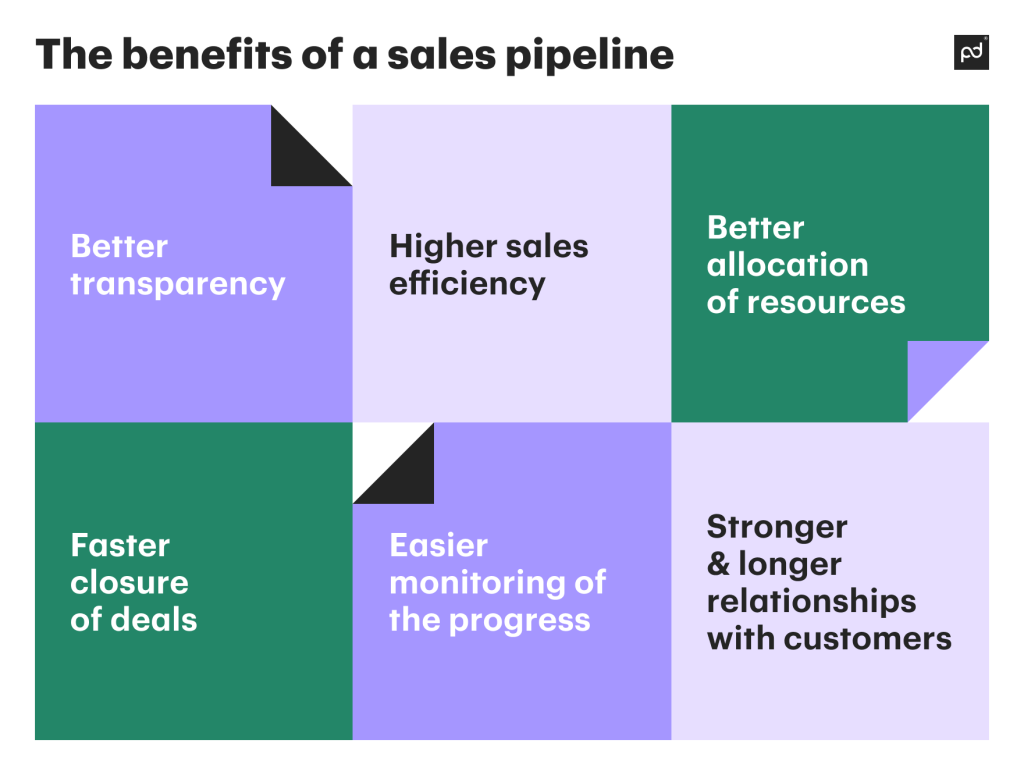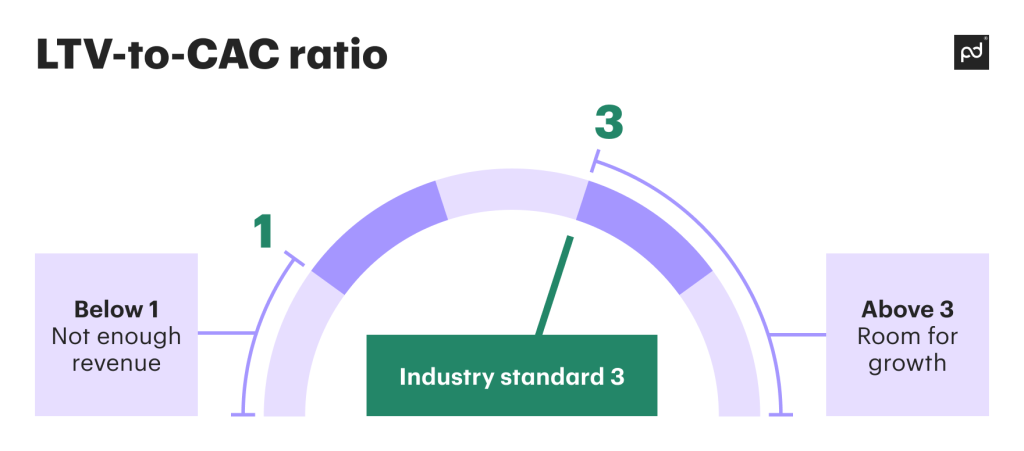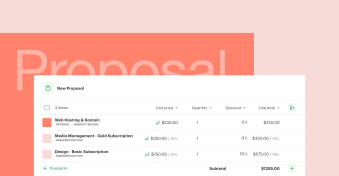For every business, it’s crucial to establish a steady stream of leads for generating the same stable revenue.
As Invesp claims, 80% sales require five follow-ups, and 3 out of 5 customers prefer to say “No” four times prior to saying “Yes”.
Along with that, 48% of salespeople never even make a single follow-up, and 44% of the rest make just one before giving up.
As you can see, a messy sales process is the shortest way to receive less than your business is capable of with all other things being equal.
Building and maintaining your sales pipeline is the best way to handle this process, making your sales activities systematic and way more efficient.
With that in mind, let’s dive in to explore the following: what a sales pipeline is, why it’s important, what the main metrics are to track your sales pipeline, how to build and maintain it efficiently, and how to maximize your revenue using the sales pipeline.
Let’s go!
What a sales pipeline is?
We’ll start by clarifying the definitions of the terms we use here.
The pipeline is a popular approach to present the journey of your customer (prospect, lead), focusing on the stages of this journey and the actions of your salespersons required for moving prospects from their previous stages to the next ones.
In other words, the pipeline is a model of the customer journey illustrating it step-by-step, from being a prospect to becoming a buyer.
There is, however, another concept called the sales funnel, which exists in tandem with the sales pipeline. You can find out more about the differences between these two concepts in our special article.
Why the sales pipeline is important — briefly
As we said before, a sales pipeline is a valuable tool for managing and growing a company’s revenue.
- First of all, the pipeline and corresponding data pieces allow you to track the progress of potential sales and identify where you are in the sales process. This information can be used to forecast future sales and make adjustments to the sales strategy as needed.
- The pipeline also allows sales teams to prioritize leads and focus their efforts on the most promising opportunities.
- Additionally, it helps to identify any issues or bottlenecks in the sales process that may be preventing deals from closing.
The benefits of a sales pipeline
All models are wrong, but some are useful
George E. P. Box
The sales pipeline functions as a model presenting your sales process from a perspective of the stages your potential customer goes through to become an existing customer.
And, as with any other model, it can be rather useful.
The sales pipeline is aimed firstly at increasing your revenue and streamlining the sales regimen.
Let’s take a look at certain benefits this concept brings to your business when implemented into your sales and marketing processes.

1. Better transparency
Once the pipeline is built, it helps you to see the whole picture, including important steps to analyze:
- How long does it take for a prospect to move from one particular stage to another?
- Which stages cause the highest drain of prospects?
- What are the results of your decisions?
With the big picture in your hands, you can manage the sales process holistically and systematically.
PandaDoc’s sales solution offers a wide range of tools making this process streamlined and efficient.
2. Higher sales efficiency
With a complete and unbiased understanding of the stages of your sales pipeline, you can leverage them, achieving higher efficiency.
For example, you can analyze and shorten the average time required for moving between the stages, which leads to a boost in sales.
Or looking at the drain rates, which helps optimize conversions to increase the percentage of initial prospects turning into customers.
Also, by having more prospects at the start, you can effectively process, set priorities, and choose only those that have the highest chances to become your buyers.
3. Better resource allocation
Using the sales pipeline, you’re better prepared to know how to distribute your sales and marketing resources in the most efficient way.
This means, for example, that you can focus your efforts on the prospects with higher conversion potential.
Or save some resources rather than spending them where the result is unpromising.
4. Faster closure of deals
Controlling all your sales pipeline, you can manage most of its parameters in order to close your deals faster, as well as to speed up your sales cycle simultaneously.
You can find out more about how to seal your deals faster and more efficiently, in our article.
5. Easier progress monitoring
This benefit is fully related to one of the previous ones about transparency.
Using the pipeline, you can track the activity of each sales team member separately. This makes it possible to see who works enthusiastically — and who doesn’t.
6. Stronger, longer relationships with customers
With a well-crafted sales pipeline, your relationships with the customers don’t stop soon after the purchase.
Ideally, your satisfied customers should then become advocates of your brand and help to boost your sales for free, just because your product or service is that good.
The stages a sales pipeline should include
Though the structure of a sales pipeline can differ from company to company, you can narrow down the more common stages.
1. Lead generation (or prospecting)
This is the first step in the sales pipeline, also known as prospecting.
This is a crucial stage, as it’s where you identify potential customers and distinguish them from others.
2. Lead qualifying
Once leads are generated, the next step is to qualify them.
This involves narrowing down the list of leads to only those who have a genuine need for your product or service and have the budget to pay for it.
Furthermore, it’s essential that the qualified leads are decision-makers in their respective companies.
3. Sales meeting (or sales call)
The next step is to have a sales meeting or call with the qualified lead.
This is an opportunity to present your company and your products/services, discuss the prospect’s needs, and make any necessary adjustments to your offer.
With advancements in tech, remote meetings via Slack or any other online communication platform have become easier to arrange.
4. Proposal sending
If the meeting goes well, it’s time to send a proposal tailored to the prospect’s specific needs.
Proposal management software can assist in crafting the most relevant offer and tracking the prospect’s behavior.
By the way, PandaDoc has everything you need for efficient proposal management — including proposal creation (whether from scratch or using a template), effective document collaboration tools, e-signature features, advanced notification system and much more.
5. Deal closure
The resulting (but often not the final) stage is deal closure, which is a binary fork in the road: either the deal is successful or it isn’t. If the deal is closed, the agreement must be signed, typically electronically.
It’s worth mentioning that you should efficiently manage all the possible “No’s” from your prospects. This means, among other things:
- You should ask follow-up questions to understand the reason behind an objection
- Objections usually trace to several different types of reasons — a lack of budget, a lack of trust, not the right time, not the right product or service, etc.
- Sometimes “No” is simply a hard no; otherwise, you should identify whether it’s actually a “Maybe” in disguise, and if it’s possible to turn that undesired “No” into a glorious “Yes.”
6. Retention
The last step is retention, where satisfied customers become loyal advocates for your product or service, returning and encouraging others to do the same.
These advocates help sell your product or service sincerely and at no cost.
The main sales pipeline metrics
Prior to building your own sales pipeline, let’s review the main metrics for tracking the performance of your sales activities.
Qualified leads number
A qualified lead number is a metric that tracks the total number of inbound and outbound leads in a sales pipeline.
It is important to track this metric, as it helps to ensure that the sales team has enough leads to generate revenue and grow the business.
If the number of qualified leads is low, it may indicate a need for more marketing efforts or a need to review the sales team’s lead generation strategies.
MQL-to-SQL conversion
This metric measures the percentage of marketing-qualified leads that become sales-qualified leads.
It is a critical metric to track in the sales pipeline as it helps to identify the efficiency of both the sales and marketing teams’ efforts.
A high conversion rate indicates that the teams are effectively working together to identify and nurture potential customers.
A low conversion rate, on the other hand, could indicate that there is a misalignment between the teams, or that the marketing team is generating leads that are not ready to buy.
Average deal size
The average deal size represents the average revenue generated per deal.
It is an important metric to track in the sales pipeline because it helps businesses to understand the value of the deals they are closing and plan for the future.
By knowing the average deal size, businesses can determine how to allocate resources such as team members and budget to focus on deals that will generate the most revenue.
Additionally, it helps to identify the types of deals that are bringing in the most revenue and focus on targeting similar deals in the future.
Win rate
The win rate metric shows the percentage of qualified leads that turn into customers. It is one of the key metrics to track in the sales pipeline.
By monitoring win rates over specified periods of time, such as quarter to quarter, businesses can identify trends and make data-driven decisions on how to improve their sales processes.
If the win rate is dropping, it may indicate a need for more training, better sales enablement tools, or changes to the sales process.
On the other hand, if the win rate is high but total sales are not where the business wants them to be, it may indicate a need to focus more on marketing efforts to bring in more leads.
Customer lifetime value (LTV)
The LTV shows the total value a customer brings to a business over the course of the business relationship.
This metric is especially important for e-commerce companies.
By analyzing the LTV of different customer segments, businesses can identify which segments are the most valuable and tailor their sales and marketing strategies accordingly to increase the lifetime value of those customers.
Additionally, by monitoring the LTV over time, businesses can identify trends and make data-driven decisions on how to improve their customer retention and increase revenue.
LTV is also used for evaluating the customer acquisition cost (CAC), and the LTV-to-CAC ratio helps companies understand how efficiently they are acquiring customers.
Customer acquisition cost (CAC)
Customer acquisition cost is a metric that measures the cost of acquiring a new customer for a business.
To calculate the CAC, businesses can divide the total costs of sales and marketing by the number of new customers acquired.
By keeping track of the CAC, businesses can identify if they are spending too much on sales and marketing and make adjustments to optimize the budget.
Additionally, a company’s CAC can be compared to the lifetime value (LTV) of a customer to understand how much money a business is making from a customer over a period of time.
It can also be used to calculate the LTV-to-CAC ratio which, as mentioned above and detailed below, is a metric to understand efficiency with respect to how well a business is generating profit.
A low CAC is desirable, as it means that the business is able to acquire customers at a low cost, which ultimately leads to more profitability.
LTV-to-CAC ratio

The LTV-to-CAC ratio compares the lifetime value (LTV) of a customer to the customer acquisition cost (CAC). The ratio is calculated by dividing the LTV by the CAC.
A high LTV-to-CAC ratio is desirable, as it indicates that the business is acquiring customers at a low cost while generating high revenue from them over the course of their business relationship lifetime.
A low ratio, on the other hand, suggests that the business is spending too much on acquiring customers and may not be generating enough revenue to cover the cost.
For SaaS companies, the industry standard for LTV-to-CAC is 3:1.
If a company’s LTV-to-CAC ratio is below 1:1, then it is not generating enough revenue to cover the cost of acquiring customers.
If it’s above 3:1, it is a good sign that the company is efficiently acquiring customers and has room for growth by increasing its marketing efforts to bring more leads.
Average sales cycle duration
The average sales cycle duration is a metric that measures the length of time it takes for a sales team to close a deal.
By analyzing the average sales cycle duration, businesses can identify deals that are stagnating in the pipeline.
This allows businesses to zero in on these deals and to understand what went wrong, and strategize on how they can move these deals forward faster.
Additionally, by analyzing the average sales cycle duration, businesses can also identify areas of the sales process that need improvement, such as follow-up, or the need for better sales enablement tools.
Sales by customer
Sales by customer is a sales pipeline metric that measures the total sales broken down by each customer account.
This metric can help identify which customer segments are driving the most revenue and inform strategies for targeting specific types of accounts.
Sales by rep
This metric shows the sales number each sales representative has made.
It is aimed at the sales performance of individual reps and allows you to make data-driven decisions on how to optimize their sales processes.
For example, if one rep is consistently outperforming the others, it would be beneficial to speak with that rep and learn what, if anything, they are doing differently.
This information can then be implemented into the sales training process to help improve the performance of the entire sales team.
How to build and manage your sales pipeline efficiently
Let’s assume you have a certain lead generation and nurturing process, running on its own, without requiring much oversight or control.
In other words, before the start, you have a list of your prospects, your own sales processes, and your goals for revenue.
But without a pipeline, you:
- Cannot predict any numbers of your future sales or even leads, both in a long- and short-ranged perspective.
- Cannot track and optimize both team-wide and personal performance of your sales.
- Cannot efficiently manage the allocation of required resources.
- Cannot prioritize leads, tasks, or other activities.
- Cannot optimize or automate routine processes and tasks.
To solve the issues mentioned above, you should build your sales pipeline and then use it actively for managing your sales processes.
Below are the main steps you should do to build and manage your sales pipeline.
- Define your target market, identify who your ideal customer is, and create buyer personas to help you understand their needs and pain points.
- Use a common pipeline structure as a template for starting your own. Customize the stages in accordance with your special situation.
- Analyze your current leads and distribute them into the stages of your pipeline. Using any competent CRM system is a must.
- Once the pipeline is built and launched, refine it. For example, you can add an extra stage for a specific prospect connection type which is common for your business domain only.
- Set up the KPIs and metrics you’ll track for keeping your sales pipeline under control.
- Create guidelines for your sales staff about how to maintain the pipeline properly.
- Continuously check your pipeline and update it accordingly to increase its efficiency.
For a deeper and more comprehensive understanding of how to build and manage your sales pipeline with higher efficiency, read our e-book How top sales reps fill their pipeline: Tips for today’s competitive environment.
Tips on how to boost your revenue with the sales pipeline
Building your sales pipeline and getting it up and running is a big deal, of course. Now, let’s go over some tips on how to turbo charge it and make your pipeline even better.
1. Review your pipeline early and often
Each competitive market is constantly changing, so you should always be ready to adjust your pipeline to any new changes.
The faster you identify and handle a necessary change in the market, the better your sales process will adapt to it.
2. Review your pipeline stages critically
Sometimes, the list of stages turns out to be too big or too short.
Remember, your pipeline is just a model, and you can make it more helpful by dividing broader stages into narrower ones or combining the short ones into larger ones.
Sometimes such actions can substantially optimize the sales cycle.
3. Pay particular attention to prospect qualification criteria
Ideally, you should identify prospects with both the most and the least potential at the earliest possible stage.
A good practice is to find some markers for a quick prospect exclusion from your pipeline.
4. Receive customer feedback and elaborate on it
Sometimes, your prospects can be extremely helpful in making your sales process more streamlined.
Ask them about your product or service, your approach to communication, etc.
Often, customer feedback can be quite unexpected for you and disruptive to your sales process — and that may be a good thing, very much worthy of your attention.
5. Using a CRM system is a must
Building your sales pipeline on a sheet of paper is an absolutely obsolete and inefficient approach.
You must manage the process using CRM software like Salesforce or Pipedrive; otherwise, you’ll soon find your sales process in a terrible mess.
6. Use other third-party tools to get additional insights or increase overall efficiency
Integrating your sales automation software with some third-party tools can help you increase conversions at different stages of your sales pipeline.
For example, the PandaDoc contract management tool, equipped with a free e-signature feature, makes the contract negotiation stage significantly shorter and hastens the deal closure by 18%.
How PandaDoc can help you manage your sales pipeline
The sales pipeline is a powerful tool for modeling, tracking, analyzing, and optimizing your sales process.
It allows businesses to set up transparent sales tracking with easier progress monitoring, better allocate sales and marketing resources, and boost revenue by increasing sales efficiency and closing deals faster.
Sales pipelines typically contain several stages which vary slightly depending on the type of business.
It has a variety of important metrics you should track in order to make your sales process more streamlined.
Adhering to the guides presented above, you can build and manage your sales pipeline with high efficiency.
The success, however, also depends on the tools you’re using within the management process.
It’s highly important to use a CRM with sales automation tools integrated to succeed.
PandaDoc is a proper suite for managing your sales pipeline efficiently.
Offering sales automation and document management features, as well as integrations with the most popular CRM systems, it makes it possible to run all your sales activities within a single software environment.
Disclaimer
PandaDoc is not a law firm, or a substitute for an attorney or law firm. This page is not intended to and does not provide legal advice. Should you have legal questions on the validity of e-signatures or digital signatures and the enforceability thereof, please consult with an attorney or law firm. Use of PandaDocs services are governed by our Terms of Use and Privacy Policy.
Originally published November 27, 2017, updated April 3, 2023


